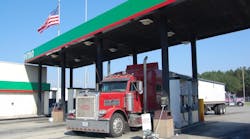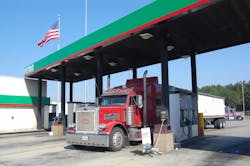To that end, the Energy Information Administration (EIA) – an arm of the Department of Energy – is offering an explanation and while it’s focused entirely on the reasons why the retail pump price for gasoline continues to skyrocket across the country, some of the same reasons apply to the diesel price hike as well.
“[While] the rise in gasoline prices is partly due to higher crude oil prices, most of the increase in the pump price of gasoline reflects an increase in the gasoline crack spread – the difference between the wholesale price of gasoline and the price of crude oil,” the agency noted in its analysis of this contentious issue.
Between January 1 and February 19, the price of Brent crude oil—the waterborne light sweet crude grade that drives the wholesale price of gasoline sold in most U.S. regions—rose about $6 per barrel, or about 15 cents per gallon, EIA noted.“A simple calculation – one that modestly understates the role of higher crude prices to the extent that crude price increases during December 2012 were still not fully passed through in retail gasoline prices at the start of 2013 – suggests that about two-thirds of the rise in gasoline prices since the start of the year reflects higher gasoline crack spreads,” the agency added.
Indeed, in a related analysis of the fuel price picture, the agency added that throughout much of November and December 2012, gasoline crack spreads were very low, and in some cases negative: with a barrel of gasoline worth LESS than a barrel of Brent crude. (Go figure THAT one out!)
As a result, retail gasoline prices were lower than one would typically expect given prevailing crude oil prices, with the lowest price of 2012 reached in EIA's weekly survey on December 17. Since the beginning of 2013, though, reformulated gasoline blendstock for oxygenate blending crack spreads versus Brent increased 12, 34, and 46 cents per gallon, respectively, by Feb. 18, in New York Harbor, the Gulf Coast, and Los Angeles.
Not just higher oil prices are at work here, though. For example, EIA noted that some of those “other” factors contributing to rising crack spreads or margins for gasoline, and therefore to rising retail gasoline prices, include:
- Refinery outages: There have been multiple refinery outages, both planned and unplanned, that reduced U.S. capacity to manufacture gasoline.
- Global demand for petroleum products: Year-over-year global product demand is up, and further rises are expected. That rise in demand affects domestic refinery utilization rates, maintenance needs, and product balances.
- Prior low crack spreads: Throughout much of November and December 2012, gasoline crack spreads were very low, and in some cases negative (again noting that a barrel of gasoline was worth less than a barrel of Brent crude oil late last year).
Both planned and unplanned maintenance at several refineries are supporting higher crack spreads, with “offline” refinery capacity increasing from the beginning of 2013 to more than 1.7 million barrels per day (bbl/d) for the week ending February 15. As a result, EIA estimates that gross inputs into U.S. refineries fell 9% – from 15.9 million bbl/d per day in mid-December to 14.4 million bbl/d for the week ending February 15.
EIA added that while U.S. exports of petroleum products continue at a robust level, the relationship between product exports and domestic gasoline prices is quite complex and exports do not appear to be contributing to rising U.S. pump prices since the start of the year.
In fact, as U.S. demand for gasoline and distillate has declined, robust global demand for petroleum products has provided Gulf Coast refineries with an export market for gasoline and distillate produced using capacity that would otherwise have been operated at lower utilization rates, the agency noted with strong global demand for distillate fuels in recent years has been a factor allowing refiners to operate profitably with lower gasoline crack spreads than would otherwise have been possible.Indeed, over 80% of U.S. exports of total gasoline are produced and shipped from the Gulf Coast, while the vast majority of U.S. gasoline imports enter the country along the East Coast, according to EIA’s data.
Still, even though U.S. gasoline exports have also increased in recent years, America remained a net importer of gasoline in 2012, the agency said.
On top of that, constraints on product pipelines between the Gulf Coast and the Northeast regions and the limited availability and expense of vessels permitted to move product between U.S. ports, which must be built, maintained, and flagged in the U.S. and employ U.S. crews, limit the amount of petroleum products that can be moved economically from the Gulf Coast to the Northeast.
And don’t thing reducing exports would help, as EIA thinks if gasoline exports were to be constrained, global gasoline supply would likely decline, and U.S. gasoline importers, especially in the Northeast, would face additional competition for supplies from buyers in other countries that would have otherwise been supplied from U.S. refineries, which would tend to raise the price of imported gasoline.
Yet, from where the agency sits atop its data-gathering enterprise, the pricing “tea leaves” seem to indicate a welcome retrograde movement in prices isn’t far off. How long that will last, though, remains vexing question.
“Despite the recent increases in wholesale and retail gasoline prices, there are indications that gasoline crack spreads are beginning to ease,” the agency noted, adding that 11 million barrels of waterborne gasoline are en route to the U.S. and Canada.
“U.S. refinery maintenance typically peaks in February, and we expect that many of the facilities that have recently decreased crude runs should return to normal operations in the coming weeks,” EIA pointed out. “However, this increased supply will likely be countered by the seasonal increase in demand, which typically begins in the spring. As a result, the short-term outlook for gasoline prices remains volatile [and] it is possible that a part of the rise in wholesale prices has not yet been fully reflected in pump prices.”







